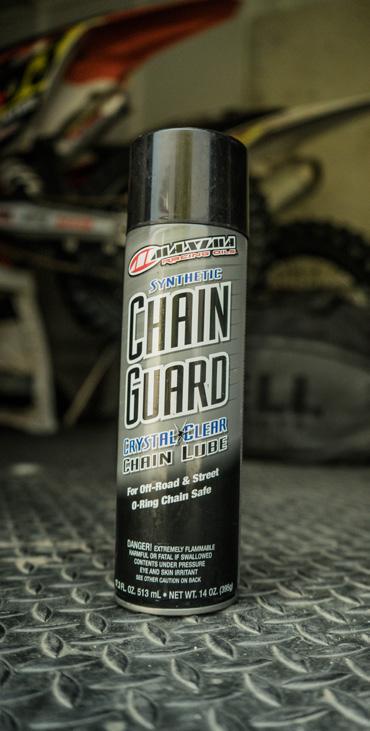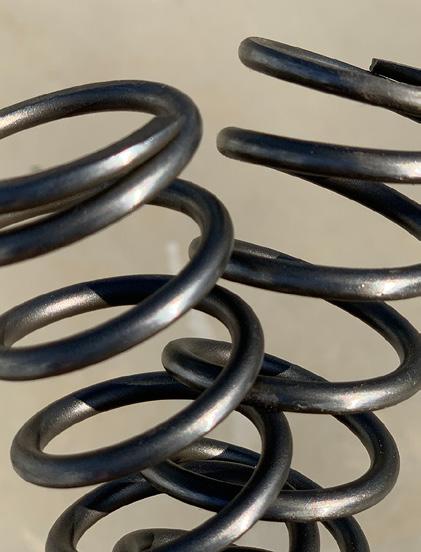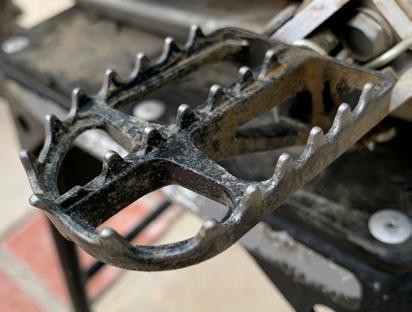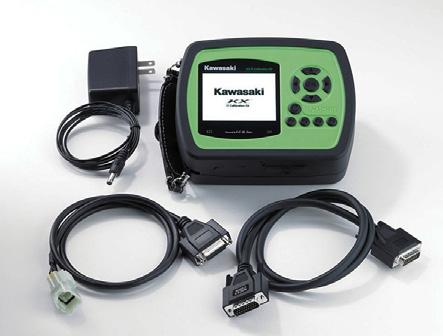
11 minute read
MAXIMA SYNTHETIC CHAIN GUARD
by dirtbiketest
MAXIMA SYNTHETIC CHAIN GUARD BY: JIMMY LEWIS
ROOST - Great application - Migrates and penetrates - Does not fling off
Advertisement
ENDO - Each same-size can varied in volume of chain lube
WHAT IT IS - Lube for your chain, it’s that simple
Maxima Synthetic Chain Guard is an advanced chain lubricant specifically formulated for motorcycle chains. It uses a synthetic lubricant base with anti-wear and pressure additives that Maxima believes are superior to any other chain treatment. It also contains special additives to prevent and protect against rust and corrosion, as well as keeping the lube adhered to the chain. Chain Guard is O-ring safe and is also claimed to be an excellent lubricant for all motorcycle control cables. It is available in 6- and 14-ounce can sizes in aerosol spray and retails for $7.50 and $11.50 respectively.
HOW IT WORKS - Lubricates the chain reducing wear and adding water resistance
We won’t go as far as to say chain lube has as religious of a following as two-stroke oil, but in the field you can get some pretty dedicated views on the subject. For some reason we don’t feel the chain needs as much respect as the piston and rings but they are both equally important in the grand scheme of things–no chain, no go. The chain’s job is much more easily visualized which lends itself to a dirty life in our world.
At DBT, we pride ourselves on doing common sense approach long-term, semi-scientific testing. We may not have a controlled

laboratory setting, but we do the best we can to have a realworld laboratory nonetheless. With access to a fleet of rental bikes and a wide variety of test riders using dirt bikes for all sorts of uses, we regularly put stuff into testing without knowing we are “testing” it. Maxima supplied products for some of our longterm bikes and we started keeping track of wear on similar parts using different methods of lubrication. The first and most obvious standout result was with chains and sprockets.
Simply put, Maxima’s Chain Guard is a first class product that does everything it claims. From the simple things that might go unnoticed--like the spray power from the can along with the quantity delivered to the foaming action of the lube. All the way to its stick and penetration into the chain. Our impression is that Chain Guard is one of the best. It has a very controlled flow and it spreads onto the chain without needing to be over applied. The chemical prevents corrosion even in very harsh soils and repels moisture as good as anything we have used. It sticks to the chain and does not do too much of the “oil stringers” that end up leaving lube on your swingarm if you don’t let the bike sit after lubing.
Our protocol for lubing chains is to do it right after a ride when the chain is still warm. This leaves a coat of lube on the chain before the bike is washed to help keep water out. Here you can see the water bead up on the chain verifying the lube is working. It also allows lubing of the O-rings so they don’t degrade. On non-O-ring chains, the lube works its way under the roller surfaces as good as anything and it semi-dries in place which we verified by breaking a chain apart after a lube–this will also help keep water out. Once dried, the lube doesn’t fling off and there is minimal attraction of dirt. Over application will produce a gummy coating to the chain but that isn’t the product’s fault. Maxima makes a chain cleaner product for those that tend to over apply. We never felt the lube attracted enough dust or dirt to be of a concern and it seems to “wear off” a little slower than others.
Though we never felt ripped off or too confused, the published size of the can and the contents numbers on the side of the can never seemed to match up. Blame world-wide distribution and maybe the metric system or something. There is the big can and the little can. And prices will vary depending on where you find it. Regardless, it is a fair value even at full retail. Plus since it does not take as much lube to get the job done, the can lasts a lot longer than we would have expected.
Here is where we state the obvious and some other things we have learned. A standard production chain that was not lubed lasted about half the lifespan of one that was lubed regularly. The lube brand did not make a noticeable difference (we were using a few.) In very close inspection, you could not see any standout differences in any of the lubed chains in wear. Some allowed a little more corrosion on a chain left out in the weather, but the Maxima lubricated chains showed minimal rust. It should also be noted that on a previously rusted chain, the Synthetic Chain Guard cleaned up the chain way better than expected. So what it came down to was the application and the durability of the lube once on the chain, and Maxima proved one of the best.
2019-2021 KAWASAKI SETUP TIPS, 2021 20-HR REVIEW BY: SCOTT HOFFMAN
The KX450 has been one of the top 450s in its class for several years now and, even with only minor updates for 2021, it’s still on top with many media outlets. The KX is an everyman’s 450, meaning it can easily be adapted and setup for a very wide variety of riders and rider weights. DBT likes this bike but stresses how simple setup and fairly affordable upgrades will garner the best results for KX owners.
Riding the Bike Stock:
Most can ride the bike stock but DBT found that for faster riders and heavier riders the chassis is (or can be) a little unbalanced. The front fork is a little soft and can blow through the stroke in whoops, braking bumps, and hard hits. The fork is plush and when you start to go too far in on the compression adjuster, it starts to compromise the fork’s plush feel. When the clickers start to get to the 7-8 turns out or less mark, you can feel the fork not working on both fronts. If this is an issue, first try increasing the oil volume by adding 5cc-10cc of fork oil to each leg. This is not a cure but it helps.
Fork Fix:
You can send your suspension to a tuner for the full setup but we suggest you first try this trick before spending nearly a grand on full suspension mods. The best fix that we have tested is to simply change the fork spring rate on just one fork leg from a standard 5.0 N/mm to 5.2 N/mm. In a sense, you are making a 5.1 N/mm rate. This mod alone allows most riders to back out the clickers, maintain a plush ride in the chop, and the fork resists blowing through the stroke better, and there is less pitch overall front to back. You have to either buy a full set of aftermarket springs or you can pick up one side from a dealership (Kawi P/N 44026-0228). If you are over 215 pounds, you can go up the full rate on both sides.
Stock Fork Settings:
C: 8-11 clicks out R: 9-11 clicks out Fork height: 0mm/Flush
With Stiffer Springs
C: 12-14 clicks out R: 10-12 clicks out Fork height: 2mm exposed
Shock:
The rear shock works pretty well. We have ridden a few bikes with revalves that work better for heavier riders but the stock shock is tunable for a really wide variety of riders. It’s not perfect but it gets the job done. Spring rate: 54 N/mm (stock) Hi-compression: 1 1/8 to 1 1/4 turns out Lo-compression: 15-18 clicks out Rebound: 11-13 clicks out Race sag: 104mm-106mm
Handlebar Position:
Don’t be afraid to test different bar positions, especially on the 2021. The ’21 bar is now 1 1/8 over the older 7/8 and offers a slightly different bend and height. On the ’21, taller riders found moving the bar to the forward position with the mount in the back position allowed them to corner better and forced them forward on the bike. Conversely, shorter riders under 5'10" did not like the change.
Ignition/Fuel Mapping:
This is not an easy fix unless you have access to Kawasaki’s tuner or a performance shop that can make changes. The stock coupler is the best overall for most riders but we still felt it is too abrupt right off idle when exiting corners and a little slow building revs in the mid. With adding or subtracting fuel or advancing or retarding the ignition, we can move the power delivery around or control how fast it builds. With the stock coupler we like to smooth it right off idle at 0-1/2 throttle and then advance the ignition and remove a little fuel into the mid-range to liven up the power curve. On the aggressive green coupler, some really like the feel. However, several test riders felt they could make it better by slowing down the speed the revs pick up in the mid. If you like the stock and aggressive couplers, another option is to reprogram just the black or mellow coupler, this way you can easily test it against the other two maps.



Exhaust:
The second option to breathe a little more spunk into your KX450 is simply replace the stock muffler or install a full system. FMF and Pro Circuit come to mind but there are also a host of other options. The replacement muffler is often lighter than stock, smaller, and puts out better power. With the FMF, for example, we almost always retain the spark arrestor/end cap stuffer for best results. Without the stuffer it just builds the power way too quick and spins the rear tire too much. This might make you feel like a hero for a lap or two but overall it just wears you out. But even with aftermarket exhaust, slight mapping did make it better to specific rider needs.
Gearing:
For the most part the stock gearing works really well but a few heavier riders found themselves between gears at times with the bike in stock trim. Going up one tooth makes third gear more versatile on tighter tracks. It allows you to use third in more turns and reduces having to shift as much.
Clutch:
To be honest we never had any real issues with the 2019-2020 clutch. The action was not the best but we often just removed the judder spring for a better feel and durability. Basically you remove the judder and half plate and replace it with a standard clutch plate. Yet the 2021 clutch and its action are much improved. 2019-2020 guys having issues might have to go with a Hinson, for example, or buck up and buy a 2021.
Rear Brake and Front Brake Lever:
These are two areas that have bugged some of our test riders. The rear brake is too touchy and the front lever is too narrow. To help the rear brake we had to be creative with sprays and even go as far as removing surface area on the pads. Lowering the brake pedal helps, but without more mods it can only go down so low. As for the front brake lever, those with big hands often replace the levers with an ASV or Arc lever for more contact surface for their digits.
Fuel and Temperature:
There was a weekend we must have picked up some bad fuel, the KX on that day showed signs of detonation under hard loads and big throttle positions. Be sure to always run premium fuel from a trusted station or if you can’t find quality fuel, maybe mix race fuel 50/50 with pump fuel. We have always run pump fuel but only had an issue one time.

Some have said the KX can get warm and leak coolant, we have never had the issue ourselves. If you are having issues or ride in a lot of deep sand or tracks that put big loads on the engine, a quick fix is to swap radiator caps from the stock 1.1 to a 1.8.
Test Mule:
We have 21+ hours on the 2021 and other than normal maintenance, scratches, and partially worn chain and sprockets, the bike is holding up really well. One of our test riders has 50+ hours on his 2020 and his maintenance log has been as follows: Chain and sprockets, chain roller, rebuilt/revalved suspension, tires, oil and filter changes, upgraded levers, tires, Pro Taper 1 1/8 handlebar, FMF Exhaust, and new graphics.
The KX450 is a workhorse and liked by many. In stock trim it does like to have a few things updated or tuned for best results. For 2022 we hope Kawasaki keeps their basic current platform with just upgrades such as adjustable maps on the fly, power tuner app, new spring and valving specs, and new exhaust to name a few key points. But for now, just a few items and we are off to the races on the 2021.
















